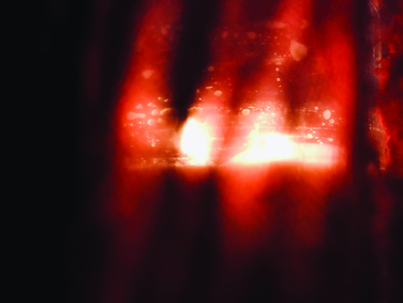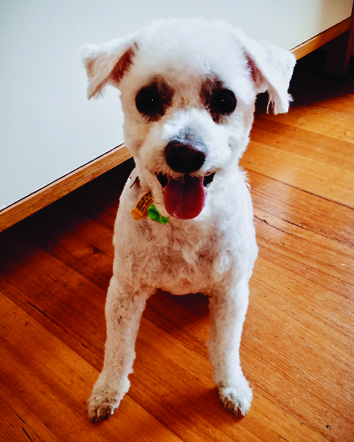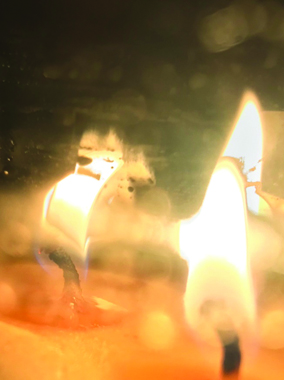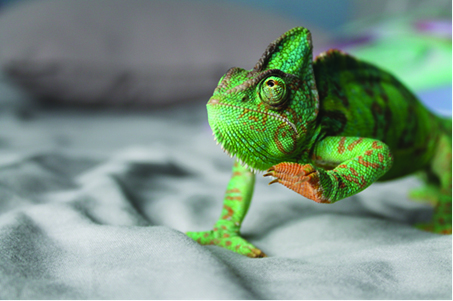FIGURE 1 | Ariel Moy, 2018, The shimmering light of Values, seen from time to time (photograph)

| Creative Arts Educ Ther (2018) 4(2):190–197 | DOI: 10.15212/CAET/2018/4/28 |
Creative Dialogue: A Process for Research Supervision in Higher Education
The MIECAT Institute, Australia
Abstract
Arts-based research is an approach to post-positivist and post-modern research that has gained much traction in Australian universities and institutes of higher education. It is a tradition that aims to generate and represent knowing through arts-based modalities, and emphasises expression of the unexpected, multi-focussed, sensual, ambiguous and indirect aspects of experience. What is less common is the integration of this approach into teaching and learning in the context of higher degree research supervision. This article describes a multi-modal creative dialogue between a doctoral candidate and her supervisor that demonstrates how the arts can enhance understanding of the underpinning paradigms that inform a doctoral thesis.
Keywords: arts-based, intersubjectivity, multimodality, postgraduate supervision, lived experiencing
Introduction
This paper describes a creative dialogue between a doctoral candidate, Ariel, and one of her research supervisors, Jan. Ariel’s doctorate is an arts-based inquiry into an exploration of her own, and three research participants’ experiences of maternal holding.
This particular creative exchange occurred towards the end of Ariel’s candidature as she prepared to rework sections of her final thesis draft. The dialogue began with an invitation for Ariel to take time to consider the values that underpinned her research, to refine her understanding of these so that her values might be made explicit in her thesis, and to communicate a clearer sense of these values to her supervisors.
The dialogue
In response to the invitation Ariel emailed the following to her supervisors.
I have spent quite some time working with, and refining my values for the inquiry because of the looming presentation on my methodology in September. I can see that I have not always explicitly stuck to these values in the language that I have used in the thesis, nor been as clear and firm about them as perhaps I could be, right from the beginning.
I have engaged with my guiding values as ‘entities’ in an artistic way (creating a micro-play) in the hope that it would convey to myself and you both where I stand.
Characters
Note: Sometimes all these characters appear together if my gaze is soft and I focus on the qualities of the shimmer.
FIGURE 1 | Ariel Moy, 2018, The shimmering light of Values, seen from time to time (photograph)

FIGURE 2 | Ariel Moy, 2018, A white dog known as Emergence (photograph)

Setting the scene
Ariel and her values sit around a campfire at night.
Values: Why are we here?
Ariel (shaking her head): You’re always here, aren’t you? You colour and shape how I know and how I am in the world.
Values: We are powerful – we are the axiology that has given form to your ontology (yes, the radical intersubjectivity) and to your epistemology (that focuses you on the moment to moment multimodal experiences of coming to know).
Ariel: Yes, but sorry, I pay little attention to you most of the time. Unless I’m asked to pay attention.
Now giving you attention, I know you’re at the heart of everything. I chose maternal holding because of you. When I held my son, I felt your presence, I still do. I felt you so strongly in my own experience, and knew you would guide me in working with others – how could you not?
Intersubjectivity: Ariel radicalised me. I’m not just the power or occasional by-product of specific human relationships in her research, I illuminate the presence of all relationships always, everywhere. I am fundamental; a first principle if you like.
Ariel: I’m an introvert, I value the space that I alone take up by the fire, my felt sense of separateness.
Intersubjectivity: But you know when I’m here you don’t lose yourself, you’re still you, or you wouldn’t have included me in the research. First, you’re not aware of me most of the time, maybe in moments of deep love or terror. And I’m not always about relationships with other human beings, I’m here with you and the fire, or you and the forest, the engagement of you with your dreams, imagination, thoughts or memories.
A chameleon who has thus far remained still opens its eyes.
Multimodality: Well, I’m here too.
Values shimmers around and through the chameleon.
Values: Ooh, you picked a second one of my facets?
Ariel (to Multimodality): You reminded me of Values, you’re everywhere and you change shape (the chameleon turns red and puffs out like a balloon), sometimes you’re an emotion, sometimes I feel you in my chest or through my skin, sometimes you’re bringing things out into the open with words, sometimes I notice you in what is happening between myself and another.
Multimodality: I do go everywhere. I’m pretty fabulous (the red chameleon becomes a misty outline of itself).
Values: You don’t have as many forms as me.
Multimodality: It helps humans to bunch me into categories, it helps them understand one another and themselves. They can pay attention to different forms of me: one minute thoughts, emotions and sensations, another minute, imagination, creativity, relationships. We bring something different to their experiencing and knowing.
Ariel (to Multimodality): I couldn’t ignore you when I held my son, so many bits of you flitted in and out of my awareness.
Multimodality: You thought your mothers would feel that too?
Ariel: I didn’t want them to miss out, you bring the gift of surprise, there’s so much more to experiencing and knowing than what we say with words.
A small white dog reappears by the fire.
Emergence: And here I am.
The dog vanishes.
Ariel: Wait!
Values: A third facet!
Values shimmers around the space where the dog had been.
Emergence: And here I am.
The dog vanishes again.
Values (sighs and flattens out toward the ground): I thought I was the star attraction?
Ariel: Yes and no. Emergence steals the show at certain points, if I pay attention. Particularly when I want to find out more about what’s happening right now, it’s not always comfortable though.
Emergence: And. Here. I. Am.
Ariel: If I stay with the present moment I can try and sense, or even show or tell you what I notice in the moment even as its changing. I see the way the firelight sparkles off your black eyes Emergence, I feel the touch of a soft breeze when I see it play across your fur, I remember times before when you’ve appeared, I can show you in my smile what it means to have you here...
Emergence: Stay with me. Stray from me.
Emergence vanishes.
Values: Any more guests?
Ariel closes her eyes and puts her right hand out for the white dog.
Ariel: Just the three, it was enough, so much comes with them and they all play well together.
Values: Yes, having us here with you means you’ll have to stay open to us, think of ways to include us, you’ll need to be clear about how you welcome us into the inquiry and how you share us with your mothers and materials and ideas and other voices.
The white dog reappears. Ariel’s hand rests on its back. The lights cluster around them as the chameleon sidles to rest between them.
Ariel: I’m grateful to have had the chance to figure out who I wanted with me in this inquiry.
Values: We would have been there anyway.
The red light thins out as it expands beyond the fire to include the outskirts of the forest.
Ariel: But now I can see you and share you, be guided by you.
Emergence: And now I’m here.
The end.
FIGURE 3 | Ariel Moy, 2018, A collection of candle-less flames known as Intersubjectivity (photograph)

FIGURE 4 | Cécile Brassuer, 2018, A chameleon known as Multimodality (photograph), sourced from unsplashed

In the forming of a response to Ariel’s creative research writing, Jan’s aim was to consider what of the material presented was strongly resonant (either consonant or dissonant) to her understanding of axiology as it pertained to Ariel’s inquiry and to bracket this into her response. Within a supervisory context such conversations are offered to encourage optimal intersubjective learning (Allen, 2004) and ideally entail a collaborative enactment of openness to uncertainty and ambiguity, iterative reflexivity, and emotional efficacy all within a process orientation.
Jan’s response to Ariel
Characters
Ariel and her Values
Setting the scene
The different forms of Ariel’s values shift and shimmer depending on her focus. Sometimes Values doesn’t seem to be there at all.
Ariel’s values take a number of rather strange forms including a collection of candle-less flames, a white dog, and a chameleon. There are possibly many more but that’s for another time.
When Ariel focuses softly they come together as a shimmering red light.
Ariel set up a meeting with her values – to get a bit clearer about their energy or substance and how she and they interact.
Values: Why am I here?
Ariel (shaking her head): You’re always here, aren’t you? You colour how I know and how I am in the world, and in fact how the world appears to me.
Values (glowing a little brighter): I sound powerful.
Ariel: Yes, but sorry, I pay little attention to you most of the time. Unless I’m asked to pay attention, which is why we are here.
Values: What role do I play in your inquiry?
Ariel: You’re at the heart of it – in fact you are at the heart of most of what happens in my life. I chose maternal holding because of you. When I held my son, I felt your presence, I still do. I felt you so strongly in my own experience, I thought it worth giving you the chance to guide my way with others.
Values: You cannot be without me, you cannot know without me.
Ariel: But I can question you and develop and form qualities of you. I chose you to guide this inquiry and together we shaped how you manifested.
I am curious about your different forms and facets…
Values: The form of candle-less flames shows our fundamental ontological belief – that we are all, and always in relationship. Intersubjectivity, is fundamental and radical. We come you know ourselves as subjective beings through our relationships.
Ariel: It’s confusing sometimes because my experience is so often that I am alone, an introvert, sitting by the fire. I feel separate.
Values: But think about it – you are in relationship with the fire, the room in which the fire exists, you feel separate because you know there are other people somewhere else. There are so many forms of intersubjectivity, that coexist overlap, fall into and out of awareness – its dynamic, and difficult to language sometimes.
And also, your experience of feeling separate is about a form of knowing. Sometimes we know via a bodily felt sense that shifts into images, emotions, thoughts, and during this process we focus on a sense of us being a separate entity. Sometimes we “know” that we are part of something bigger, that we are part of a web of interconnectedness … and this is where language fails us I think.
Ariel: You’re everywhere and you change shape (the chameleon turns red and puffs out like a balloon.
Values: I’m pretty fabulous (the chameleon becomes a misty outline of itself).
Ariel: You bring the gift of surprise. A small white dog shimmers by the fire
Values: Well this is where attending to experience – moment by moment is so wonderful. Rather that hauling out a previous “script” of what we have come to know if we try to remain descriptive of what is happening to us (which is of course intersubjective) then maybe our script will shift. This is allowing emergence.
So, the ontology of intersubjectivity is intertwined with the epistemology of emergent multi-modal knowing (beautifully and somewhat simply articulated in the participatory paradigm).
Ariel: If I stay with the present moment I can try and sense, or even show or tell you what I notice in the moment even as its changing. I see the way the firelight sparkles off your black eyes Emergence, I feel the touch of a soft breeze when I see it play across your fur, I remember times before when you’ve appeared, I can show you in my smile what it means to have you here...
Values and Ariel sit quietly together. They are apparently quite still, yet the energy and flow of their ever-shifting focus and interactions is palpable.
Ariel’s response to Jan
Engaging with my values in the form of a dialogue with them – as entities – enabled me to really get to know them as ‘fully fleshed’ beings, to let go of a kind of cognitive understanding of them and invite in a more embodied, emotional and image-based feeling for them. Importantly it allowed me to question them about my uncertainties. Your response Jan then felt like these characters and you both connecting in with me, understanding me and helping me evolve my understanding of them. Allowing myself to be ‘in relationship’ with these values, and inviting you into that relationship, and then having you really inhabit that relationship spoke to my uncertainties and my conceptual knowing and developed them into a fuller knowing. Like Heron and Reason’s (1997) extended epistemology, there was a sense of grounding in and congruence between all forms of knowing.
About the Author
Jan Allen. For the past 20 years Dr Jan Allen has been an Academic Director at The Miecat Institute, a not for profit higher education provider in Melbourne, Australia. In 2017 Jan resigned her position and is currently a part time senior staff member at MIECAT, supervising masters and doctoral students as well as pursuing her own arts practice. Her interests include collaborative arts inquiry, post-modern research methods, the arts in education, photography and installation art.
Ariel Moy. Ariel Moy BA Melb. (Psy, Phil), PGDip Counselling Psychology Swinburne, GDip Therapeutic Arts Practice MIECAT is a doctoral candidate and teacher at MIECAT.
Conflicts of Interest
The authors declare no conflict of interest.
References
Heron, J. & Reason, P. (1997). A participatory inquiry paradigm. Qualitative Inquiry 3(3): 274–294. doi.org/10.1177/107780049700300302